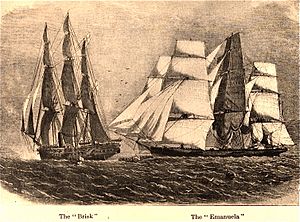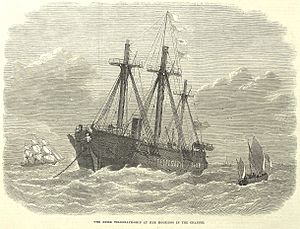HMS Brisk (1851) facts for kids

Brisk, Capt A. F. R. de Horsey drawn in 1860
|
|
Quick facts for kids History |
|
|---|---|
| Name | HMS Brisk |
| Ordered | 25 April 1847 |
| Builder | Woolwich Dockyard |
| Cost | £47,482 |
| Laid down | January 1849 |
| Launched | 2 June 1851 |
| Completed | 24 August 1853 at Devonport Dockyard |
| Commissioned | 24 May 1853 |
| Decommissioned | 19 January 1869 |
| Honours and awards |
Pacific 1854–55 |
| Fate | Sold on 31 January 1870 |
| General characteristics as built | |
| Type | Screw sloop (corvette from 1862) |
| Displacement | 1,474 long tons (1,498 t) |
| Tons burthen | 1,086 90/94 bm |
| Length |
|
| Beam | 35 ft (10.7 m) maximum, 34 ft 6 in (10.5 m) reported for tonnage |
| Draught | 14 ft 8 in (4.5 m) forward, 16 ft 8 in (5.1 m) Aft |
| Depth of hold | 20 ft 5+1⁄4 in (6.2 m) |
| Installed power |
|
| Propulsion |
|
| Speed |
|
| Complement | 170 to 175 |
| Armament |
|
HMS Brisk was a wooden ship with 14 guns, built for the British Royal Navy. It was a 'screw sloop,' which means it used both sails and a steam engine with a propeller (screw) to move. The ship was designed in 1847 and was an improved version of an earlier ship called Rattler.
Brisk was ordered on April 25, 1847, and was first planned to have 10 guns. However, because of the Russian War, the number of guns was increased to 14. It was built at Woolwich Dockyard and launched on June 2, 1851.
The ship played an important role in the Russian War of 1854-1855. It also helped patrol the waters off Southern Africa to stop the illegal slave trade. Later, it served on the Australian Station. In 1870, Brisk was sold and used for an early, but unsuccessful, telegraph service.
Brisk was the fourth ship in the Royal Navy to carry this name. The first Brisk was a 16-gun ship launched in 1784.
Contents
Building and Features of HMS Brisk
The building of Brisk began in January 1849 at Woolwich Dockyard. It was launched into the water on June 2, 1851. The ship was about 59 meters (193 feet) long on its main gun deck. Its widest part was about 10.7 meters (35 feet).
Brisk weighed about 1,474 tons when fully loaded. It needed a crew of about 170 to 175 sailors to operate.
Engine and Speed
In June 1851, Brisk traveled to Greenock to get its engine installed by Scott, Sinclair & Company. It had two large boilers and a steam engine with two cylinders. This engine was rated at 250 nominal horsepower (NHP), which is a way to measure engine power. The ship used a single propeller to move through the water.
In 1864, Brisk received a new, more powerful engine. This new engine was rated at 200 NHP.
During its first tests, the ship's engine produced about 505 horsepower, allowing Brisk to reach a speed of about 7.35 knots (13.6 kilometers per hour). After the engine was replaced in 1864, the ship could reach a faster speed of almost 10 knots (18.5 kilometers per hour).
Ship's Guns
When first built, Brisk had two powerful 68-pounder guns and eight 32-pounder guns. These were smooth-bore guns, meaning the inside of the barrel was smooth. For the Russian War, the number of 32-pounder guns was increased to twelve.
By 1856, the ship's guns were changed. It then had one large 68-pounder gun on a special rotating mount. It also had fourteen 32-pounder guns placed along its sides.
Brisk was fully ready for sea by August 24, 1853. The total cost to build the ship was about £47,482.
Adventures of HMS Brisk
First Journey: Russian War and Pacific Patrol
Brisk began its first mission on May 24, 1853. It was commanded by Commander Frederick Beauchamp Paget Seymour. The ship was sent to the North America and West Indies Station. On its way to Jamaica, it carried the new governor to Port Royal.
When the Russian War began, Brisk returned to British waters. It joined a squadron led by Captain Sir Erasmus Ommanney. This squadron sailed to the White Sea in northern Russia. They searched for Russian ships and attacked the port of Kola on August 24. The squadron left the White Sea before winter arrived and the sea froze.
Later, under Commander Alfred J. Curtis, Brisk was sent to the Russian Pacific Coast. Its job was to block Russian ports. On June 1, 1855, the squadron entered the harbor of Petropavlovsk. They found the port empty, so they destroyed the gun batteries and storage areas. On June 7, the crew saw a volcano called Kozelsky erupt. After the war ended, Brisk returned home and was taken out of service on June 13, 1857.
Second Journey: Fighting Slavery in Africa
After nearly two years, Brisk was back in service. In 1859, it was commanded by Captain Algernon F.R. de Horsey. The ship was sent to the Cape of Good Hope Station in Southern Africa. One of its main tasks was to patrol the seas and stop ships involved in the illegal slave trade.
On September 15, 1859, Brisk also helped search for the famous explorer Dr. Livingstone near the River Kongone. In November, the ship rescued survivors from the Barretto Junior, which had run aground on a reef near Mayotte.
A notable event occurred on August 10, 1860. Brisk captured a fast sailing ship called the Emanuela in the Mozambique Channel. This ship was carrying more than 800 enslaved people.
Captain de Horsey became ill and was replaced by Captain John P. Luce in February 1862. Brisk was then assigned to the West Coast of Africa. In 1863, the ship returned to England and was taken out of service on August 22.
Third Journey: Service in Australia and New Zealand
Brisk began its final mission on August 30, 1864, under Captain Charles W. Hope. It was sent to the Australia Station to replace another ship, HMS Miranda. Brisk sailed around the Cape of Good Hope and arrived in Sydney, Australia, on January 15, 1865.
From Sydney, Brisk was immediately ordered to New Zealand to join the naval squadron in Auckland. It arrived in Auckland on February 5. In New Zealand, Brisk helped with escort duties during the New Zealand Wars.
One of its first jobs was to transport about 300-400 soldiers from Manukau to Whanganui on March 1, 1865. After returning to Auckland, it took Governor Grey to Kawau on May 1. On May 15, Brisk received news about the missing clipper ship Fiery Star. It sailed to the Chatham Islands to search for survivors, but none were found.
On August 6, Brisk moved 300 soldiers from Taranaki to Napier. From there, it was involved in fighting around Opotiki. In early 1866, it transported more soldiers to Taranaki. After this, Brisk left Auckland and sailed around the South Sea Islands. It returned to Sydney on September 26 for repairs.
From January 10 to May 3, 1867, Brisk took Governor Grey on a tour around New Zealand's South Island. In September 1868, the ship left the Australia Station.
Brisk was officially taken out of naval service on January 19, 1869. It was then sold on January 31, 1870, to a company called the International Mid-channel Telegraph Company Ltd.
In April 1870, Brisk was anchored off the coast of Cornwall, England. It was part of an experiment to create a telegraph service in the middle of the sea. The idea was to have a ship act as a floating telegraph station. However, the project faced problems like broken cables and sea-sickness among the telegraph operators. The experiment ended after only two months, in June 1870. By August 1870, the telegraph company went bankrupt, and Brisk was sold again.
Legacy
Brisk Bay in Queensland, Australia, is named after HMS Brisk.




